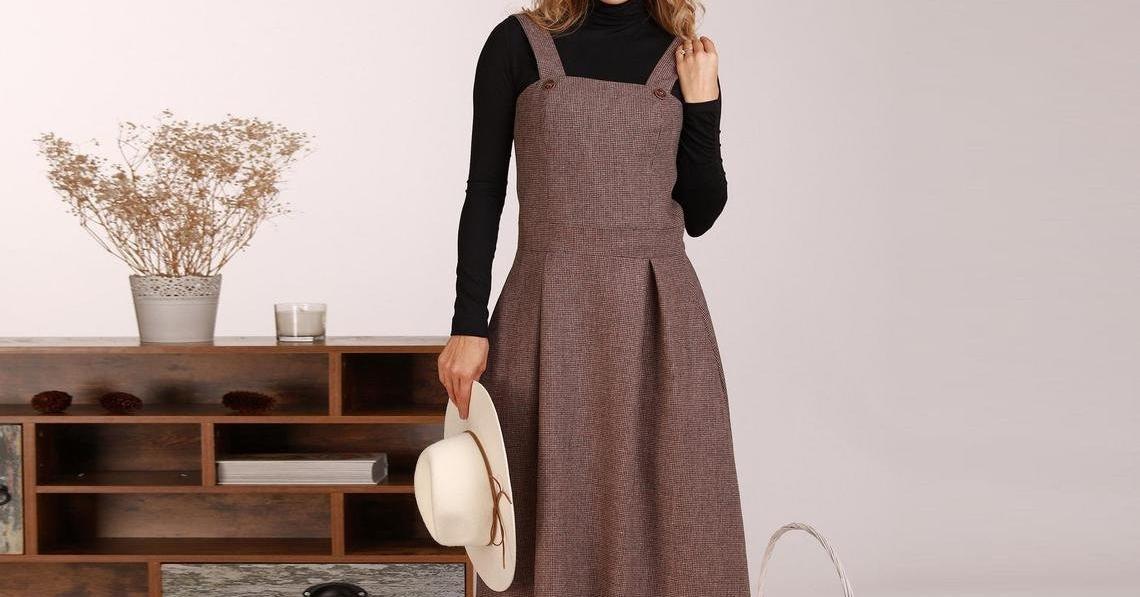Are you curious to know what is a pinafore? You have come to the right place as I am going to tell you everything about a pinafore in a very simple explanation. Without further discussion let’s begin to know what is a pinafore?
Fashion is a fascinating journey through time, filled with trends that come and go, and styles that withstand the test of time. One such enduring classic is the pinafore dress. Often associated with innocence and charm, the pinafore dress has a rich history and continues to grace runways and wardrobes to this day. In this blog, we’ll explore what a pinafore is, its origins, how it has evolved over the years, and why it remains a beloved fashion choice for many.
What Is A Pinafore?
A pinafore is a type of sleeveless dress, typically characterized by a bodice (the top part of the dress) attached to a full or A-line skirt. What sets the pinafore apart is its design, which features straps that go over the shoulders and cross at the back, securing with buttons or ties. These straps form a distinctive crisscross pattern on the wearer’s back. Pinafore dresses can vary in length, from shorter styles that graze the thighs to longer ones that reach the knees or even ankles.
Origins And History
The term “pinafore” is derived from the word “pinafored,” which means “pinned before.” Pinafores trace their origins to aprons worn by women and children in the 18th and 19th centuries. These aprons were functional garments designed to protect clothing from dirt and stains while cooking, cleaning, or engaging in other household tasks.
The transition from apron to pinafore dress as we know it today can be attributed to changing fashion sensibilities in the mid-19th century. During the Victorian era, pinafores evolved into more decorative and ornate garments, often worn by young girls. They became synonymous with innocence and childhood.
Evolution Of The Pinafore
Over the years, the pinafore dress has seen various adaptations and style changes, reflecting the evolving fashion landscape. Here are some notable transformations:
- Victorian Era: Pinafores were typically long and full during this era, often adorned with lace and intricate embroidery. They were worn over petticoats and featured high necklines.
- Edwardian Era: Pinafores remained a staple for young girls but became simpler in design, with shorter skirts and fewer embellishments.
- 1920s-1930s: Pinafore dresses experienced a resurgence in popularity during this period. They were often paired with blouses and styled in a more youthful and carefree manner.
- 1960s: The pinafore dress underwent a mod makeover in the 1960s. Shorter hemlines and bold colors made them a favorite among the fashion-forward youth.
- Contemporary Fashion: Pinafore dresses continue to be embraced by fashion designers and enthusiasts. They are available in a wide range of fabrics, lengths, and styles, from casual denim pinafores to elegant, tailored versions.
Why The Pinafore Endures?
- Timeless Appeal: Pinafores have an enduring charm and nostalgia that appeals to people of all ages. They evoke a sense of innocence and simplicity in a complex world.
- Versatility: Pinafore dresses are highly versatile. They can be dressed up or down, layered with various tops, and styled for different occasions.
- Comfort: Pinafores are often lauded for their comfort and ease of wear. They provide freedom of movement and are a go-to choice for those seeking a relaxed yet stylish outfit.
- Continued Innovation: Designers continually reinvent the pinafore, keeping it relevant in contemporary fashion. New fabrics, patterns, and silhouettes breathe fresh life into this classic garment.
Conclusion
The pinafore dress is a true testament to the enduring appeal of timeless fashion. From its humble origins as a protective apron to its current status as a versatile and stylish wardrobe staple, the pinafore has remained a beloved choice for those who appreciate its charm, comfort, and adaptability. Whether you’re channeling vintage vibes or embracing modern chic, the pinafore dress offers a canvas for self-expression that transcends generations.
For more information like this visit Weji.
FAQ
What Is The Difference Between Pinafore And Apron?
Pinafores have complete front shaped over shoulder while aprons usually have no bib, or only a smaller one. A child’s garment to wear at school or for play would be a pinafore. More recently, other types of full or dress-like aprons are also occasionally referred to as pinafores.
What Is The Purpose Of A Pinafore?
The pinafore, from the Latin mantele (canvas’ fabric), can be defined as a “garment with a bib that is hung around the neck and tied at the waist. Its purpose is to protect “the wearer’s clothing” and its origin dates back at least 5.000 years.
Why Did Girls Wear Pinafores?
Originally pinafores had a very functional use and were worn mainly by young girls, but could also be worn by young boys. The girls would wear a pinafore over their dress for school or play as it helped keep the dress clean.
When Did Girls Wear Pinafores?
By the late nineteenth century, this view was firmly entrenched, meaning that young children’s dress was simple and practical. Within this context, late nineteenth century girls, young women and sometimes small boys were dressed in pinafores.
I Have Covered All The Following Queries And Topics In The Above Article
What Is A Pinafore
What Is A Pinafore Dress
What Is A Pinafore Apron
What Is A Pinafore Actor?
What Is A Pinafore Food
What Is A Pinafore?
What Is A Sexy Pinafore
What Is The Opposite Of A Pinafore
What Is A Pinafore Style
What Is A Pinafore Top
What Is A Pinafore Gown
What Is A Pinafore Vs Apron
What Is A Pinafore Used For
What Is A Pinafore Dress
How To Pronounce Pinafore
Pinafore Synonym
Pinafore Dress For Women
What Is A Pinafore
What is the purpose of a pinafore
